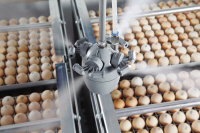



Safe, Sustainable Disinfection for the Hatchery Sector
THE NETHERLANDS - One of the key issues recently has been the use of chemical preparations to meet increasingly stringent regulations surrounding health and hygiene in the commercial hatchery, says Pas Reform. With more than 90 years invested in its global development, Pas Reform has witnessed many changes in the poultry sector, both in The Netherlands and worldwide.
One of the key debates to emerge in recent years has surrounded the use of formaldehyde and other chemical preparations, to meet increasingly stringent regulations surrounding health and hygiene in the commercial hatchery.
There is evidence that the use of formaldehyde, originally and accidentally discovered in 1859, represents a risk both to human health and to chick welfare. Yet despite mounting international pressure to eradicate its use in the hatchery, formaldehyde persists as a solution for disinfection largely for the lack of a suitable alternative.
Pioneering alternative to chemicals
In October 2011, Pas Reform signed an exclusive agreement with Watter, an award-winning Dutch company that has pioneered a clean, efficient alternative to chemical preparations, including formaldehyde.

Watter's 'Nontox' Electrical Chemical Activation (ECA) disinfection technology harnesses the power of naturally occurring oxidants using water, salt and electricity to produce a powerful, safe and highly sustainable non-toxic disinfectant that neutralizes bacteria, fungi and viruses.
The disinfecting action is the effect of combining free radicals with active chlorine compounds, such as HClO and ClO, which are produced when electricity is passed through the brine solution created by adding the salt tablets to the water.
Independent tests carried out by Dutch Organisation for Applied Scientific Research (TNO) and the Dutch National Institute for Public Health and the Environment (RIVM), have found Watter's ECA system to be effective in six key EN standards for the disinfection of Food, Hands, Medical Instruments, Rooms, Surfaces and Water Sources.
TNO laboratory studies showed that Nontox delivered at least the required 5 log reduction of various bacteria, including E.coli, Staphylococcus aureus, Enterococcus hirae and Pseudomonas aeruginosa, in accordance with European standard EN 1276. A screening test based on EN1276 test principles showed the same convincing results with MRSA and Salmonella Typhimurium target bacteria. The fungicidal effect of Nontox, including the inactivation of Aspergillus niger, was also effective to >4 log reduction, to meet EN standard 1650.
Simple, safe and sustainable
In simple terms, Watter's patented Nontox unit produces a safe, powerful disinfecting solution by adding salt and electricity to water. The result can be described as 'electrolysed oxidizing water' and with a Nontox unit installed, the hatchery can continue to supply as much of this solution as it needs, for the routine disinfection of facilities and equipment - and for fogging to sanitise hatching eggs prior to setting. The disinfectant leaves no residues on surfaces, and no build-up of resistance has been encountered in bacteria.
Putting Nontox to the test
With certification for on-farm use that confirms both claims and regulatory compliance for Nontox, leading Dutch hatchery Probroed & Sloot was the first commercial operation to test Watter's system in a live hatchery situation.
The Nontox system has a minimal footprint and in this hatchery is plumbed to an 80-litre tank that holds the ready-to-use disinfecting solution: a reserve to be drawn upon as required, for washing, fogging and other hatchery-disinfection applications - and topped up again between cycles and when demand is low.
The system is capable of producing 70-80 litres of disinfecting solution per hour and the salt tablets are supplied in sealed, conveniently sized 'whole-use' polythene bags, which go straight into the unit's hopper.
Modular configuration means that simply adding additional units to feed a larger reservoir will produce larger quantities of Nontox. And by delivering a sustainable source, on site, the Nontox system provides a convincing return, not only by reducing the costs associated with frequently repeated orders for chemicals and disinfectant over time, but also for its associated benefits to the welfare and performance of the chicks and the health of hatchery personnel.
A sustainable alternative
Nontox represents an exciting and genuine route to abolishing the use of formaldehyde in hatcheries, while respecting and protecting the welfare of people and chicks. Hatchery personnel need no longer be exposed to its harmful effects and day old chicks can be protected from the detrimental effect of formaldehyde on the tracheal microvilli.
With previous innovations including, for example, the incorporation of Microban™ into hatcher baskets and the integration of cooling pipes into the anodized aluminum walls of Pas Reform's SmartPro™ incubation system, The Watter system represents another important step in creating safer, cleaner hatchery environments.
Pas Reform has worldwide distribution rights for Nontox in the hatchery sector, and is collaborating actively with Watter to develop a variety of new applications: still further innovations that underpin Pas Reform's commitment to delivering exemplary hygiene in the modern hatchery.









